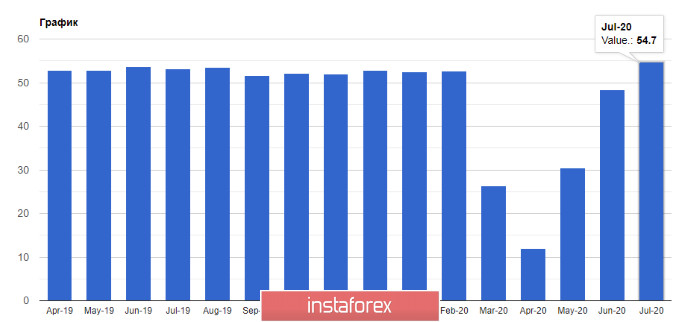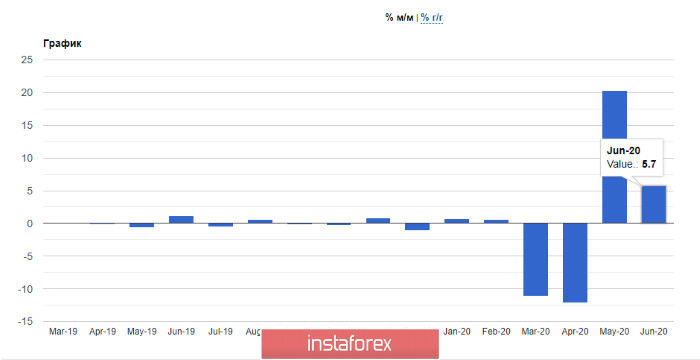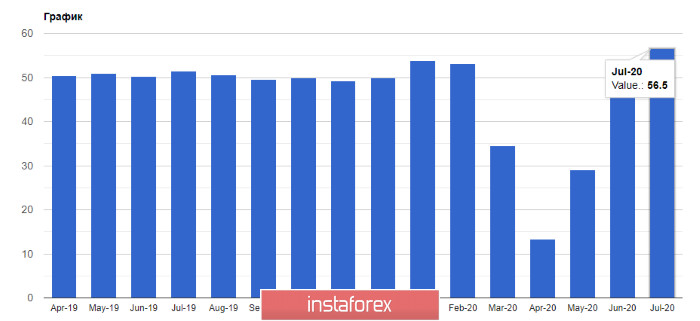EUR is carrying on its stunning bullish run against USD benefiting from a fresh batch of upbeat macroeconomic data. This time, the eurozone encouraged investors with resilience of its service sector which had received a nasty punch from the COVID-19 pandemic. The service sector needs more time to recover and get back on track than the manufacturing sector. However, since mid-summer experts affirm that business activity in the service sector recovered back to the pre-crisis level. The thing is whether the service sector will pull back after such a rapid recovery amid soft domestic demand. I'll discuss it a bit later. For a start, let's figure out statistics.

At present, it is obvious that all key indicators entered the positive territory and no one would dare to argue that. Logically, analysts say that the EU economy is set to show robust economic growth in Q3 sequentially. The only trouble for investors remains the likelihood of the second pandemic wave that will overshadow the medium-term prospects of the economic recovery. According to the Markit survey, Italy's services PMI rose to 51.6 in July from 36.4 in June, much stronger than the expected 51.1. Likewise, the service sector in France also perked up as the services PMI has been growing for the second month straight. The PMI jumped to 57.3 in July from 50.7 in June, having undershot the forecast of 57.8.
Investors welcomed the services PMI for Germany. The services PMI rebounded to 55.6 in July above the threshold level for the time since spring 2020. The index was at 47.3 in June. The forecast suggested a stronger figure of 56.7. Importantly, a further recovery will depend entirely on the coronavirus rates. Unfortunately, fresh daily updates on the coronavirus front discourage investors.
As a result of the overall uptrend in the service sector of the EU countries, the eurozone's services PMI by IHS Markit came out at 54.7 in July from 48.3 in the previous month. The PMI value above 50 indicates expansion whereas a value below 50 indicates contraction. The composite PI which includes also the manufacturing sector was upgraded to 54.9 from the flash 54.8. In June, the composite PMI was measured at 48.5. 
Besides, the eurozone released a nice report on retail sales which rebounded to the pre-crisis level. This is good news for investors betting on the reinforcement of risky assets. Nevertheless, it is too early to make conclusions. A spike in retail sales apparently comes from robust consumer activity amid reopening of national economies. So, retail sale are unlikely to remain equally strong in the autumn.
Eurostat reported that retail sales in the eurozone jumped 5.7% in June month-on-month extending a winning streak for the second month in a row. Economists had projected a bigger gain to 6.6% in June. In annual terms, retail sales grew 1.3%. We should not neglect unemployment risks which are sure to affect households' spending. The recent reports on consumer sentiment confirm the fact of a cautious attitude towards spending. This signals lower consumer activity by the end of the summer. The conclusion is obvious. A V-shaped recovery of retail sales mainly comes from delayed demand as most stores were closed during the shutdown.
Please take notice of the important factor. Uneven recovery is recorded in various regions across the eurozone. The slowest pace of recovery is typical for southern countries like Spain and Italy. As a matter of fact, they urgently need financial aid. Nevertheless, retail sales in Spain shot 16.5% and in Italy jumped 12.5%. No wonder, Germany and France revealed the sharpest bounce in retail sales.

As for the technical chart for EURUSD, the bulls are still holding the upper hand keeping the price close to resistance of 1.1860. The bulls are about to break this level that will open the door to one-week highs of nearly 1.1930 and 1.2000. Long deals would be a good idea during a downward correction from 1.1790 or from a one-week low of 1.1700.
GBPUSD
GBP is extending its winning streak against USD despite the fact that the UK services sector showed a worse-than-expected recovery, though the PMI rebounded above 50. It proves that the British service sector has gained momentum despite the Brexit-related pessimism and the lack of a trade agreement with the EU. At the same time, it is premature to say about a rapid economic recovery.
According to the survey by IHS Markit/CIPS, the revised services PMI leapt to 56.5 in July, slightly worse than the flash estimate of 56.6. A month ago, the indicator stood at 47.1.

When it comes to the technical chart for GBPUSD, a breakout of resistance at 1.3100 promoted the bullish sentiment that enables the pair to hit local highs of near 1.3170 and 1.3230. If the buyers loosen their grip at 1.3170, it would be better to postpone long deals until the middle of the channel at 1.3060 is updated. Alternatively, it is possible to buy the pair from the channel's lower border at 1.2980.





















